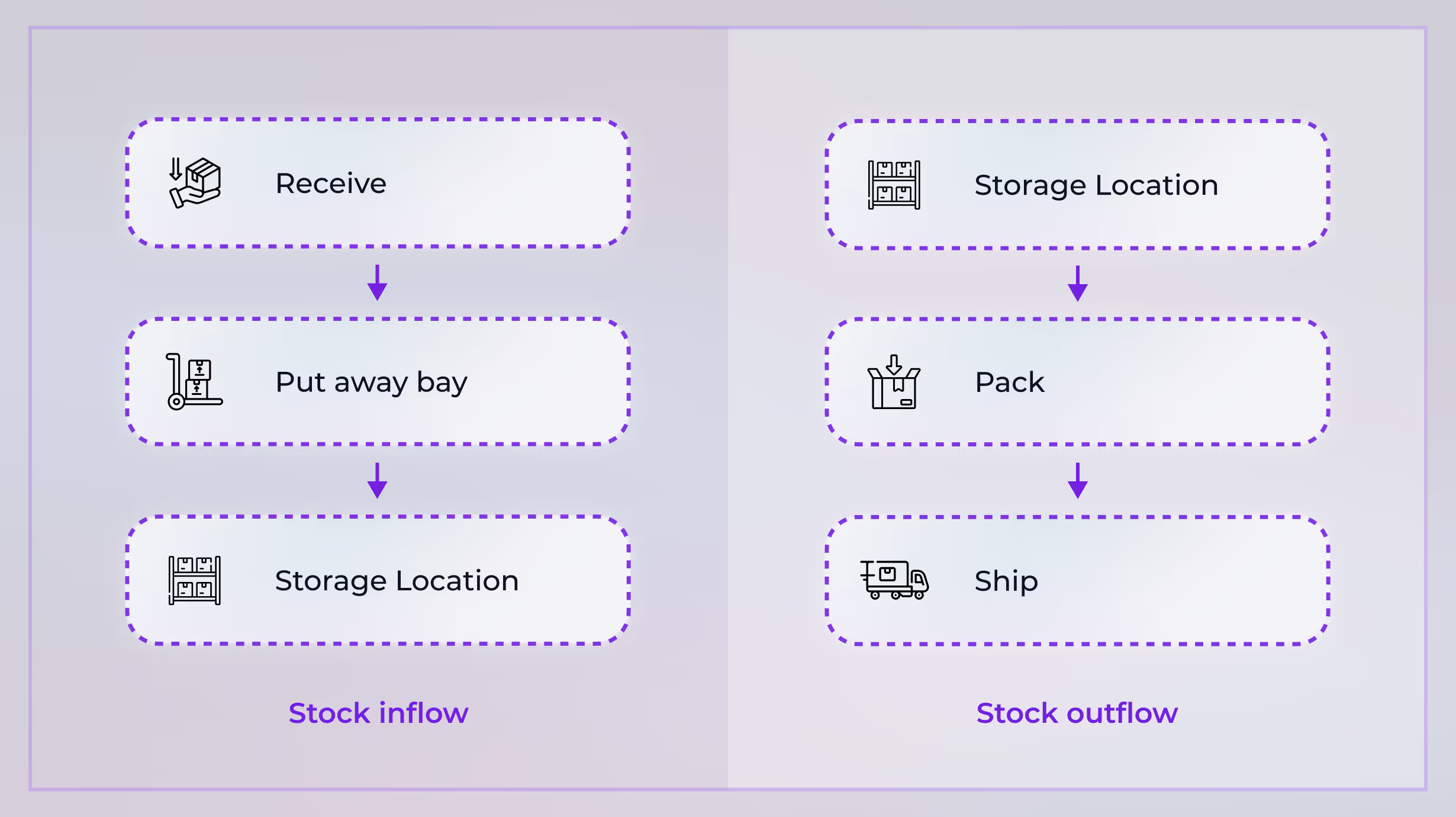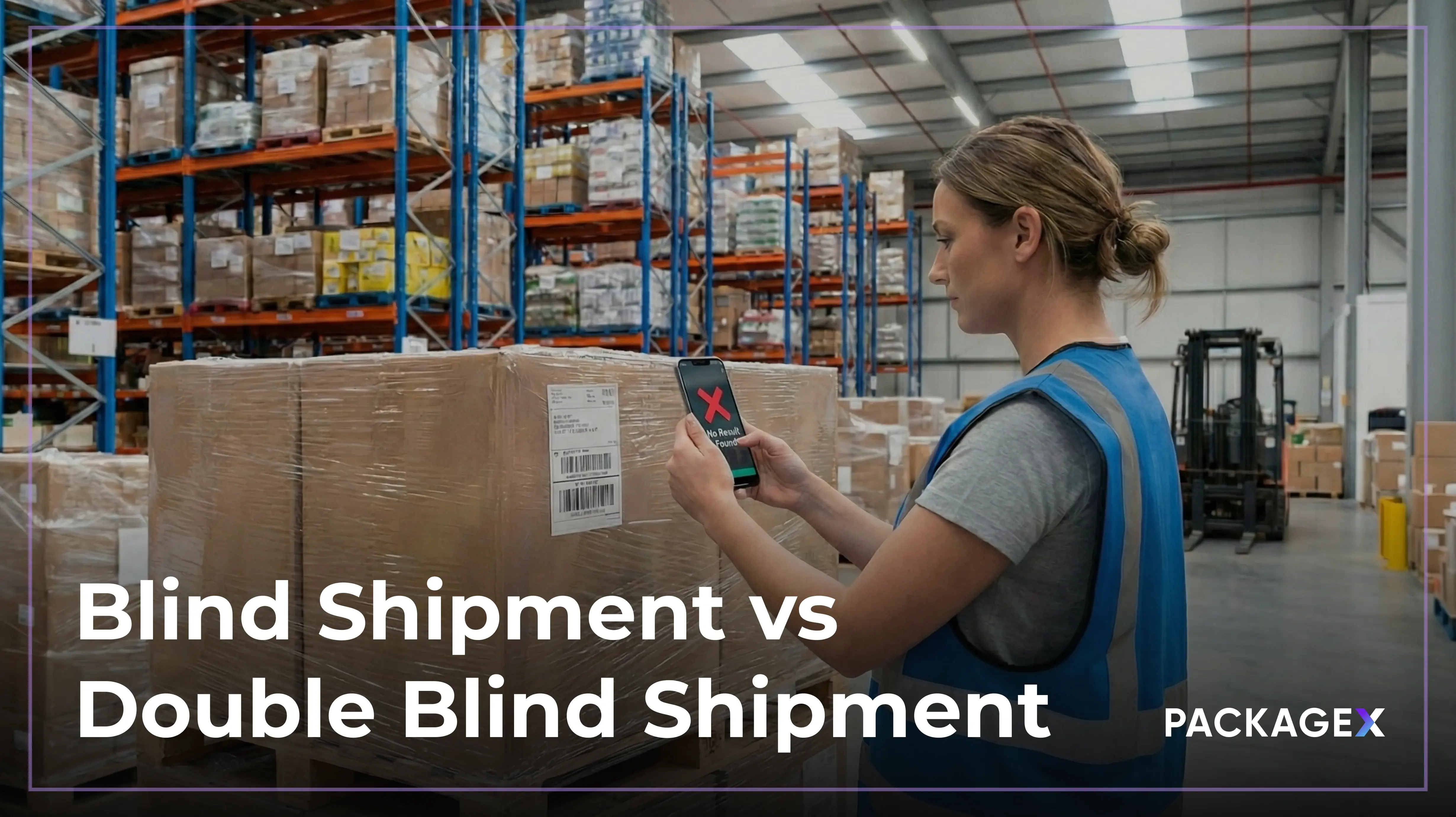Warehouse logistics plays a vital role in supply chain management because it is tied to efficient storage, movement, and distribution of products. As eCommerce surges, the demand for optimized warehouse operations grows. This pushes companies to adopt digital trends and innovative technologies. If your warehouse logistics are functioning properly, it enhances your operational accuracy, productivity, and profitability by streamlining inventory management and shipment processes. Let’s explore the core components of warehouse logistics, its advantages, challenges, and practical strategies for improving warehouse logistics. We’ll also showcase solutions implemented by industry experts like PackageX.
What is warehouse logistics?
Warehouse logistics refers to the strategic management and coordination of the physical flow of goods within a warehouse. It includes all the complex facets, from receiving to shipping, alongside the data associated with these processes. These processes plan, organize, and oversee complex operations to optimize storage, streamline movements, and ensure efficient fulfillment. By addressing both the physical and digital aspects of inventory management, warehouse logistics improves operational efficiency and meets business objectives. Keep in mind that logistics and supply chain are two different terms- explore their differences in this article.
Inflow vs outflow stock
In warehouse logistics, the physical flow of goods involves receiving products, storing them in putaway bays, and transferring them to designated storage locations (stock inflow). When a sales order is placed, products are located and shipped to customers (stock outflow).
The information flow focuses on analyzing demand and estimating fulfillment times. By optimizing and synchronizing both physical and information flows, businesses can enhance efficiency. Inflows increase stock while outflows decrease it, mirroring the interdependent nature of stock and flow systems to illustrate dynamic changes and relationships in operations.

Warehouse Components
The following are the three main elements of warehouse logistics:
- Warehouse management focuses on improving operational efficiency by training staff, managing inventory, ensuring safety, and maintaining communication with shipping partners. It also forecasts labor needs and secures proper licenses for proper logistics operations.
- Warehouse operations involve the physical movement and tracking of goods within the warehouse, ensuring efficient storage, timely delivery, and cost-effective operations. This includes receiving, organizing, and shipping products while maintaining strong client relationships. PackageX Receive helps you ensure efficient stock inflow management with accurate tracking and timely storage. So, there is no need to worry about maintaining optimal inventory levels and conducting smooth warehouse operations.
- Warehouse Management Systems (WMS) utilize AI and data-driven software to manage logistics processes in real-time. PackageX offers warehouse logistics software tools for inventory tracking, order management, and optimizing warehouse operations for better efficiency. Using PackageX’s warehouse management software, you can accelerate these operations with the power of AI. The flexible software also has integration capabilities to connect with your existing systems.
How to Set Up A Warehouse
- Select the right location by factoring in transportation costs and demand areas.
- Secure sufficient capital to cover expenses.
- Optimize the floor plan to maximize storage, enhance safety, and ensure efficient workflow, such as positioning loading bays near the road.
- Hire skilled professionals to manage warehouse tasks effectively.
- Choose appropriate equipment and machinery for warehouse operations.
After setup:
- Plan for daily operational costs to maintain financial efficiency.
- Analyze product trends to anticipate customer demand and manage stock.
- Implement software solutions for streamlined warehouse management.
- Create a strategy for handling damaged goods and customer returns.
- Develop and enforce safety policies to prevent accidents and handle emergencies.
How to Budget Warehouse Logistics
To budget warehouse logistics effectively, start by understanding potential costs and limitations early on. Your main expenses would be software licenses (based on warehouse type and operations), optional modules (custom solutions can be pricier but more tailored), server hardware or cloud hosting, and ongoing maintenance. Other than these, unforeseen expenses can average around 20% of the final budget.
Challenges of Warehouse Logistics
- Organization and Control: Maintaining precise control over inventory is difficult. You need to be able to track specific items, manage expired goods, and address shipment damages. Advanced tools like AI scanning can help you manage these with ease.
- Inventory and Space Management: Effective inventory management leads to optimized warehouse space, which is essential for balancing climate control and regulatory compliance. Without real-time inventory tracking, this can become very complex.
- Operational and Cost Issues: Challenges include managing security, handling variations in goods and shipping requirements, dealing with unbalanced shipping cycles, and mitigating rising costs and inefficiencies. Poor warehouse layout and redundancies further complicate operations.
Tips to Improve Warehouse Logistics
If you can resonate with these challenges of warehouse logistics, consider these tips:
- Start Using Advanced Warehouse Management Systems (WMS): Create automated warehouse logistics to gain real-time insights and manage inventory, order fulfillment, and overall operations more efficiently. Modern systems like PackageX let you use mobile phones for on-the-go access, which helps streamline warehouse processes.
- Provide Proper Tech Training To Personnel: Ensure that your warehouse staff is well-versed in using the latest WMS and other equipment through regular training sessions. This will help maximize the effectiveness of your systems and improve overall warehouse efficiency.
- Coordinate with Contractors and Suppliers: Collaborate closely with contractors and suppliers to synchronize delivery schedules and manage inventory effectively. Sharing delivery times and adjusting logistics accordingly can optimize inventory flow and reduce disruptions.
- Implement and Monitor Changes: Continuously monitor warehouse operations to remain flexible and dynamic, adapting processes as new equipment, employees, and products are introduced. Act promptly on identified inefficiencies by making necessary adjustments.
- Consider Fulfillment Services and 3PL Warehouse Logistics: Explore third-party logistics solutions for warehousing and supply chain management. These services can enhance efficiency by integrating with your eCommerce platform and handling aspects like warehousing, inventory management, packing, and shipping.
What You Can Learn from Amazon’s Warehouse Logistics
Amazon's warehouse logistics are renowned for their exceptional efficiency. This is largely due to the company's strategic use of random stow methods. So, items are stored in any available space, which not only maximizes space utilization but also speeds up the picking process. Complementing this method is Amazon's heavy reliance on robots in warehouse logistics. The Sparrow picking arm and the Sequoia system, for instance, handle a diverse array of tasks, further boosting operational efficiency. By integrating this mix of randomness with advanced technology, Amazon has perfected a system that allows it to fulfill orders and effectively manage a vast inventory swiftly.
{{returns-webinar}}
Advantages of Efficient Warehouse Logistics
What benefits can you gain from efficient and well-planned warehouse logistics?
- Better Inventory Management: An efficient warehouse logistics plan allows real-time inventory counts, accurate order fulfillment, and timely stock replenishment. This minimizes picking errors and lowers returns.
- Lower Costs: Maximizing warehouse space through automation, systematic labor allocation, and better demand planning can reduce operational expenses.
- Higher Customer Satisfaction: Accurate inventory and reliable order fulfillment lead to fewer returns and faster delivery times, enhancing customer satisfaction and loyalty.
- Advanced Technology: Implementing a Warehouse Management System (WMS), like the PackageX Warehouse App, enables real-time tracking, auto-replenishment, and insightful reporting, aiding in efficient space utilization and operational transparency.
Streamline Warehouse Logistics with PackageX for Enhanced Efficiency
Efficient warehouse logistics ensures smooth operations by optimizing the flow of goods from storage to distribution. This is extremely important for meeting rising demands in eCommerce. Implementing advanced technologies streamlines processes increases productivity, and enhances profitability through better inventory management and fulfillment.
PackageX's warehouse logistics tools, like its AI-driven Warehouse Management System (WMS), align with these principles by increasing warehouse efficiency in the following ways:
- Improving real-time inventory tracking
- Automating order fulfillment
- Mobile accessibility and integration capabilities simplify warehouse operations, helping businesses scale and adapt to evolving market needs.
FAQs
What does a warehouse logistics do?
Warehouse logistics include the team, systems, and strategies needed to efficiently move items in, around, and out of your warehouse. A well-organized warehouse not only saves time for employees but also cuts costs and ensures faster delivery of products and services to the market.
What are the three key parts of warehousing logistics?
The three main aspects of warehouse logistics are managing inventory, fulfilling orders, and running the warehouse facility smoothly.
What are the benefits of warehouse logistics?
Warehouse logistics provide more storage space, making it easier for businesses to manage inventory, fulfill orders efficiently, and cut down on transportation costs. They also help improve customer service and add flexibility to the supply chain.

.avif)


